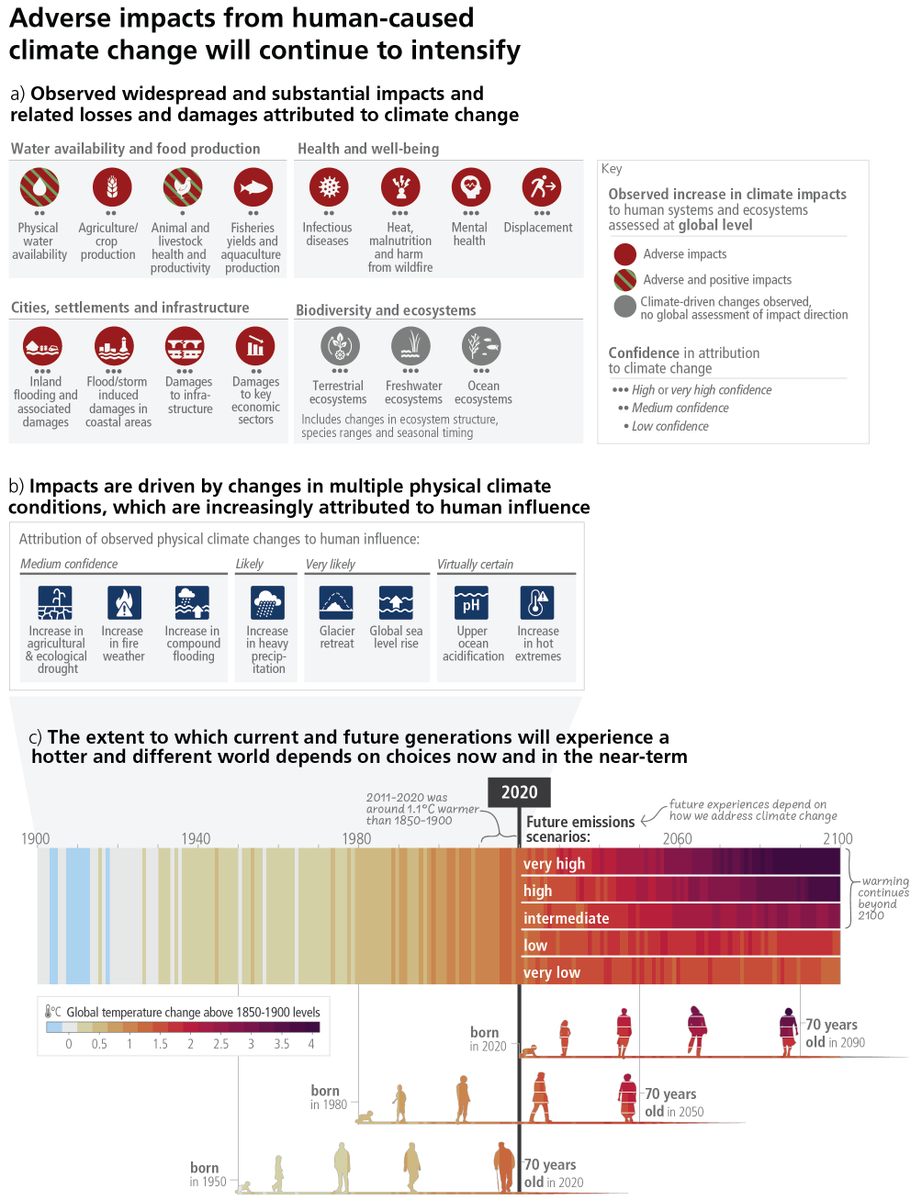The @UN #HLEGReport on Net-zero Emissions Committments is out
The problem though: #IPCC 1.5C pathways don't reach net zero GHG emissions by "2050 or sooner", but by the end of the century. The famous "net zero by 2050" (better "early 2050s) is CO2 only
un.org/en/climatechan…
1/
The problem though: #IPCC 1.5C pathways don't reach net zero GHG emissions by "2050 or sooner", but by the end of the century. The famous "net zero by 2050" (better "early 2050s) is CO2 only
un.org/en/climatechan…
1/

You might be in disbelief, but have a look at the #IPCC AR6 WG3 Summary for Policymakers, Table SPM.2:
For 1.5C with no or limited overshoot (category C1), pathways reach net-zero CO2 in 2050-2055, but net-zero GHG in 2095-2100
ipcc.ch/report/ar6/wg3…
2/n
For 1.5C with no or limited overshoot (category C1), pathways reach net-zero CO2 in 2050-2055, but net-zero GHG in 2095-2100
ipcc.ch/report/ar6/wg3…
2/n

The difference between net-zero CO2 and net-zero GHG can be explained by the dominant role of non-CO2 GHGs (methane, nitrous oxide, f-gases) in residual emissions and the dominant role of CO2 in removals
https://twitter.com/Oliver_Geden/status/1511274481997725701
You can see the difference betw net zero GHG (left) & net zero CO2 (right) also in #IPCC AR6 WG3 fig SPM.5: for 1.5C with no/limited overshoot, net-zero GHG emissions by 2095-2100, net-zero CO2 by 2050-2055. Almost completely ignored by #climate policy community so far #COP27
5/n
5/n

A major reason for these surprisingly late net-zero GHG years: the high number of scenarios in IPCC database from ENGAGE project, where IAM teams deliberately explored pathways that stay at net-zero CO2 (and therefore don't reach net-zero GHG)
rdcu.be/cZiZj #COP27
6/n
rdcu.be/cZiZj #COP27
6/n

In ENGAGE modelling intercomparison project, IAMs looked at avoiding 'peak & decline' scenarios involving the need for high levels of net negative CO2 emissions (to return from overshoot). Therefore, they are highly ambitious in the short-term
rdcu.be/cZi15 #COP27
7/n
rdcu.be/cZi15 #COP27
7/n

Large share of ENGAGE scenarios in #IPCC WG3 database (not a statistically controlled sample) has a counterintuitive effect. These scenarios are so ambitious they don't have to (!) reach net-zero GHG by 2100, shifting median to 2095-2100.
#SR15 had net-zero GHG in 2067
#COP27
8/n
#SR15 had net-zero GHG in 2067
#COP27
8/n

During approval of #IPCC WG3 SPM these late (& often missing) net-zero GHG years led to interventions by small island developing states (SIDS) successfully calling for split-up of 1.5C pathways, into those reaching net-zero before 2100 (C1a) and those that don't (C1b)
#cop27
9/n
#cop27
9/n

Main argument for splitting up 1.5C pathways (C1a/b): Paris Agreement Art. 4.1 'demands' reaching net-zero GHG by 2100 (here's an article explaining this, maybe notable there's no law scholar co-authoring nature.com/articles/s4324…)
For C1a, net zero GHG is at 2070-2075
#COP27
10/n
For C1a, net zero GHG is at 2070-2075
#COP27
10/n

Taken together, this creates a paradoxical constellation. #IPCC WG3 C1b pathways don't need to reach net-zero GHG since they're extremely ambitious. C1a pathways do reach net-zero GHG because they have to go net-negative (CO2), since until 2040 they're less ambitious
#COP27
11/n
#COP27
11/n

Even #UNFCCC NDC Synthesis Report mentions this. GHG emission reductions 2019-2030 are at 41% for scenarios that reach net-zero GHG pre-2100, and 48% for those that don't. Why would small island developing states (& their advisers) opt for 41%?
unfccc.int/ndc-synthesis-…
#COP27
12/n
unfccc.int/ndc-synthesis-…
#COP27
12/n

Now back to main recommendation of @UN
#HLEGReport on Net-Zero Committments. As we saw, "net zero GHG by 2050 or sooner" isn't backed by IPCC. Same goes for "at least 50% below 2020 levels by 2030". As we saw, #IPCC says 43% 2019-2030 (and 2020 emissions below 2019)
#cop27
13/n
#HLEGReport on Net-Zero Committments. As we saw, "net zero GHG by 2050 or sooner" isn't backed by IPCC. Same goes for "at least 50% below 2020 levels by 2030". As we saw, #IPCC says 43% 2019-2030 (and 2020 emissions below 2019)
#cop27
13/n

Finally, some 'take home' messages
➡️Modelling outputs (e.g. net-zero years) shouldn't be taken at face value, without reflecting underlying assumptions
➡️Even if taken at face value, there's a need to clearly distinguish between net-zero CO2 and net-zero GHG
#COP27 #HLEG
14/n
➡️Modelling outputs (e.g. net-zero years) shouldn't be taken at face value, without reflecting underlying assumptions
➡️Even if taken at face value, there's a need to clearly distinguish between net-zero CO2 and net-zero GHG
#COP27 #HLEG
14/n
Finally, a more general #scipol remark: If an expert group sets benchmarks it can choose whatever it likes. But choosing own benchmarks and then saying these are #IPCC numbers is misleading. This coming from a UN expert body is, quite frankly, a bit disturbing
#COP27 #HLEG
[end]
#COP27 #HLEG
[end]
• • •
Missing some Tweet in this thread? You can try to
force a refresh















